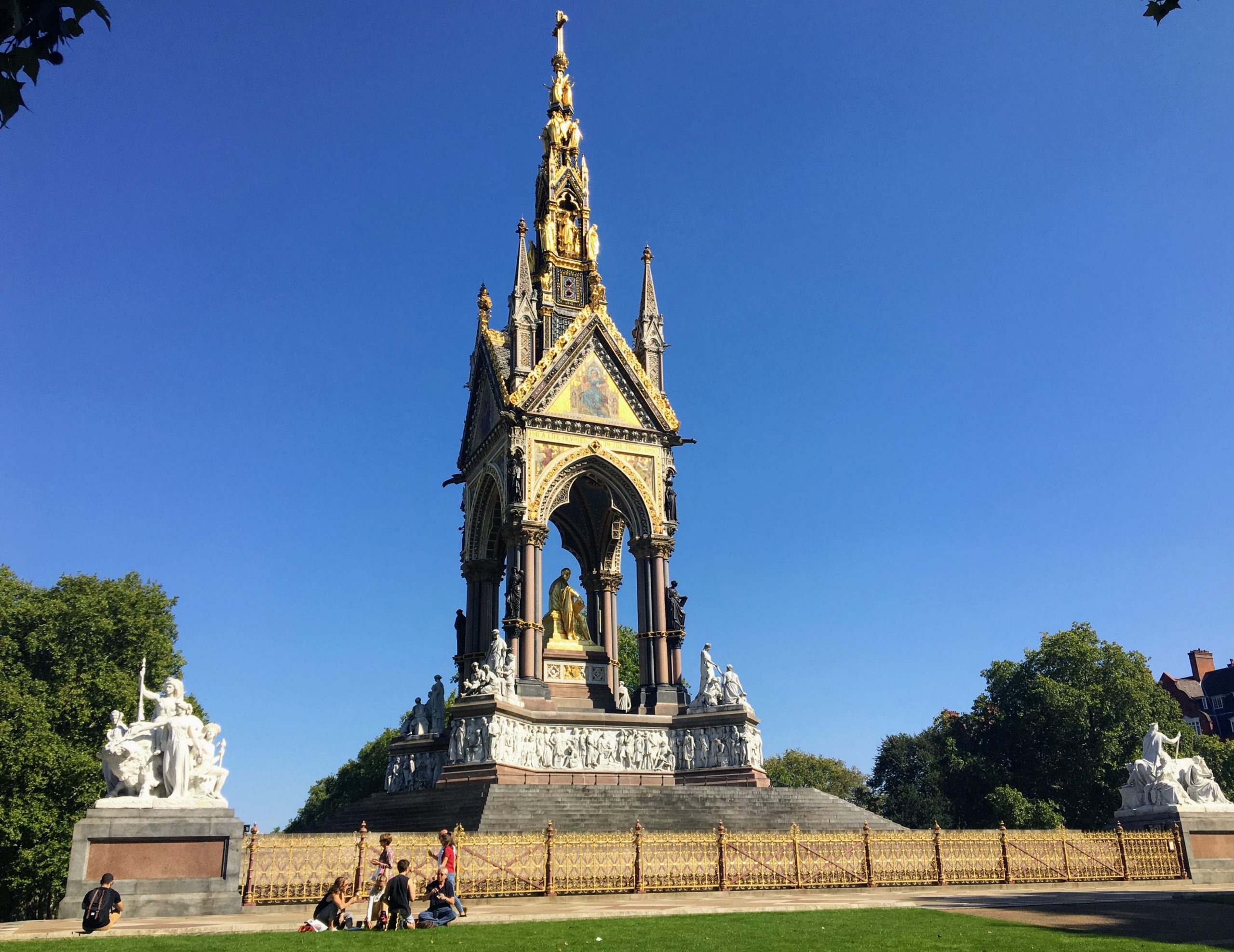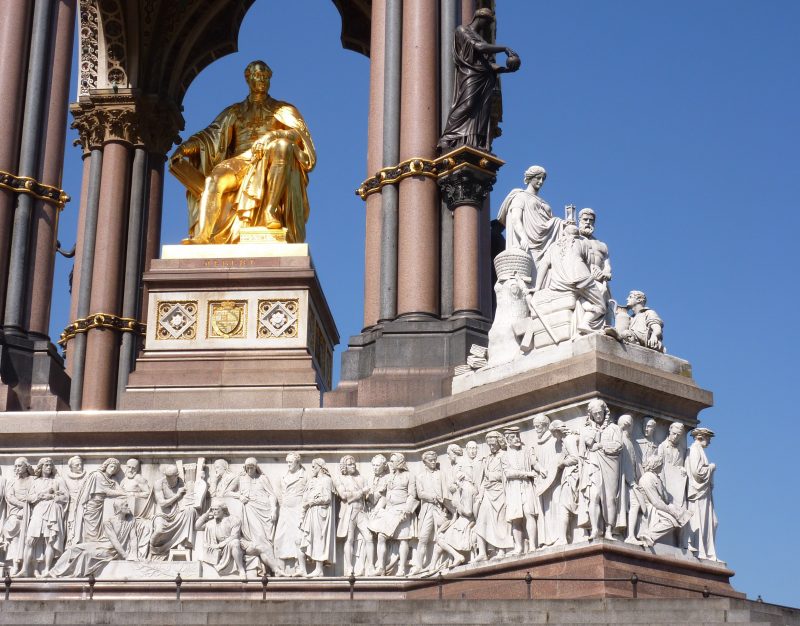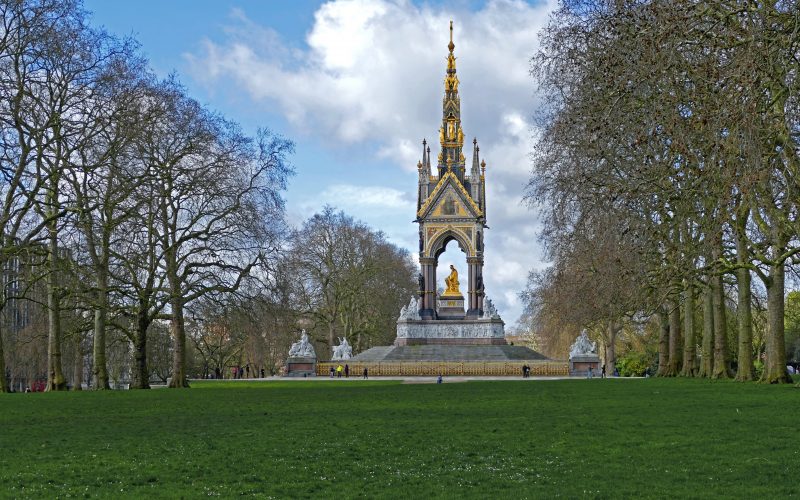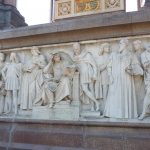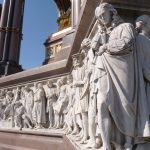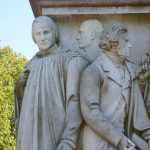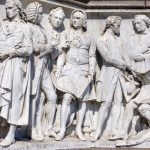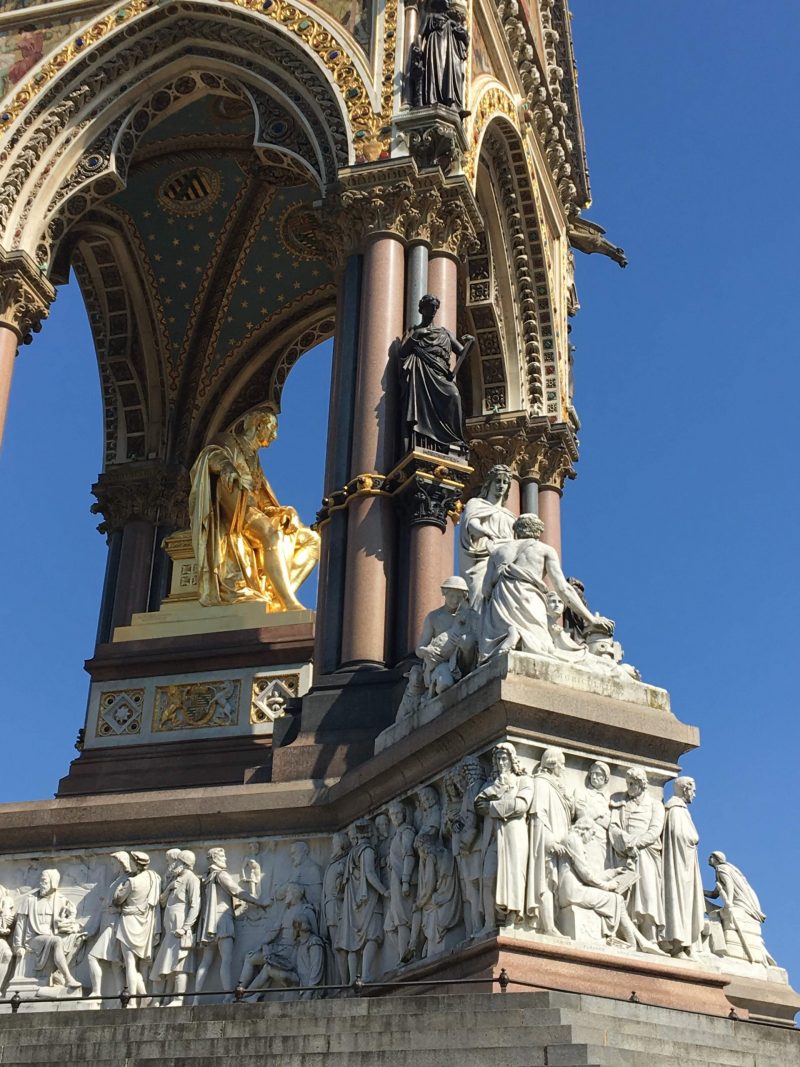When Queen Victoria’s husband died unexpectedly, it was not just the monarch that mourned as the nation too was consumed with grief along with a certain amount of guilt at not having appreciated Prince Albert and everything he had done. A grand and complex memorial was built to place Albert in the centre of arts and sciences of the 1860s.
PRINCE ALBERT
Prince Albert of Saxe-Coburg and Gotha was born in southwest Germany in an area now known as Bavaria in 1819, the same year as his wife, and cousin, Queen Victoria who he married in 1840.
As husband to the Queen, Prince Albert had little direct power or official duties. He was brought up to have a life of usefulness so was quickly bored with the life of leisure adopted by the English upper classes who enjoyed fishing and shooting. To fill his time and create a sense of purpose, he devoted himself to running the Queen’s household, estates and offices including guiding the Queen to show less partisanship when discussing political matters.
He also took on many public causes including becoming Chancellor of the University of Cambridge where he introduced educational reform, and President of the Society for the Improvement of the Condition of the Labouring Classes where he expressed his “sympathy and interest for that class of our community who have most of the toil and fewest of the enjoyments of this world”.
THE GREAT EXHIBITION OF 1851
In May 1851, Hyde Park hosted The Great Exhibition of the Works of Industry of all Nations, now remembered as The Great Exhibition. This was the first event of its kind in the world, housed in a monumental glass house filled with over 100,000 exhibits to show off British manufacturing achievements to the world. It was the first step in the vision of Prince Albert, who wanted to “increase the means of industrial education and extend the influence of science and art”.
The Great Exhibition was a huge success, attracting six million visitors between 1 May and 11 October 1851 and even making a profit of £186,000 thanks to an entrance fee of around 5 shillings plus a supplementary fee of a penny to use the flush toilets (a novelty back then). That enabled the Royal Commission to continue Albert’s vision through the acquisition of an 87-acre plot of land and the establishment of the great institutions of South Kensington: the Natural History Museum, the Science Museum and the Museum of Manufactures, which evolved into the Victoria and Albert Museum. Together these buildings became affectionately known as Albertopolis.
The 1851 Great Exhibition was identified with Albert and the work he had done for his adopted country. It brought him popularity in England, and the memorial here is probably nicer because we wished we had been nicer to him sooner.
ALBERT’S DEATH
Albert died suddenly of typhoid on 14 December 1861 aged just 42.
Queen Victoria’s inconsolable grief and prolonged mourning have become legendary. The Queen (who had been born at Kensington Palace) chose the southern side of Kensington Gardens as the site for an ornate and complex national monument that would celebrate her late husband’s achievements and recognise the British public’s deep sense of loss.
Due to the success of The Great Exhibition, it had been suggested in 1853, eight years before his death, that a statue of Albert should be erected in Hyde Park but he had disliked the idea. He wrote, ‘I can say, with perfect absence of humbug, that I would much rather not be made the prominent feature of such a monument, as it would both disturb my quiet rides in Rotten Row to see my own face staring at me, and if (as is very likely) it became an artistic monstrosity, like most of our monuments, it would upset my equanimity to be permanently ridiculed and laughed at in effigy.’
Prince Albert’s name is immortalised all over London from the Royal Albert Dock in the east to the Albert Embankment and Albert Bridge in the west. And facing the Albert Memorial is the Royal Albert Hall.
PLANNING THE MEMORIAL
The Lord Mayor and the Royal Society of Arts started the idea for a memorial, and their committee raised the funds needed. (Queen Victoria only paid for the statue of Albert in the centre.)
There was a competition for the design for the memorial and seven leading architects put forward plans: T. L. Donaldson, William Tite, Sydney Smirke, James Pennethorne, George Gilbert Scott, M. D. Wyatt and P. C. Hardwick.
Scott had already designed the iconic Midland Grand Hotel at St Pancras Station (now St Pancras Renaissance Hotel) and the red telephone box. He stood out from the other entries as he was the only architect who represented Gothicism.
George Gilbert Scott won, and he took inspiration from shrines of saints in medieval cathedrals, and the Eleanor Crosses*.
*Following her death in 1290, nine crosses (memorials) were placed in memory of Queen Eleanor where her body rested on the way from Lincoln to Westminster Abbey. The original London Eleanor Cross was made of wood and stood at the top of Whitehall, at Trafalgar Square, where the statue of Charles I on horseback can now be seen. The wooden cross was destroyed in the Civil War in the 1600s, so the present Victorian memorial was designed in 1863 to replicate as closely as possible the medieval one. Standing around 69 feet high, it was renovated in 2010 and can be seen outside Charing Cross railway station.
Scott’s fee for his own services was £5,000, which was considered moderate at 5% on the initial budget of £100,000.
It was agreed that a national memorial to Albert would best be placed near the site of The Great Exhibition and also close to the complex of museums and educational establishments in South Kensington that was already known as Albertopolis, so Queen Victoria’s Kensington Gardens request was confirmed.
The foundations were begun in May 1864, and the 167 feet (54 metres) memorial was opened to the public on 3 July 1872. The statue of the Prince came later as the ungilded bronze effigy was installed, under tarpaulins, in November 1875 and after gilding was uncovered in March 1876.
There was a lot of construction in the area as across the road, work started on the Royal Albert Hall in April 1867, and it was opened on 29 March 1871.
LOOKING AT THE MEMORIAL
Prince Albert is sheltered by a towering Gothic canopy and surrounded by statuary commemorating his good works and the glories of civilisation, especially those of the British Empire. He is surrounded by guardians representing geography, art, science and religion. The outer ring joined by ornate railings is the four continents, each represented by a series of figures and an animal.
Starting at the top of the memorial, there is a cross and orb meaning that God is above the earth. During WWII, the cross and orb were shot down by friendly fire and then replaced during peacetime (with the cross wrongly facing east instead of south).
Next down there are four gilded bronze angels, and then four more with their hands out to show they are renouncing all earthly vices.
Below the angels are statues of the Victorian virtues: Faith, Hope, Charity, Humility, Fortitude, Prudence, Justice and Temperance.
The ornate canopy, in the style of a Gothic ciborium, is decorated by ornate mosaics of four female figures on thrones: Sculptura, Poesis, Pictura and Architectura. The design for the mosaics is by John Clayton (of Clayton and Bell, more famous for stained glass) and the work was carried out by Salviati of Murano. Look closely, and you can see Sculptura is holding the plan for the Albert Memorial, but no statue is shown as that had not yet been decided upon.
Above the mosaics, there is an inscription running around all four sides. Starting on the front, it says:
Queen Victoria and her people
To the memory of Albert Prince Consort
As a tribute of their gratitude
For a life devoted to the public good
Above the vaulted ceiling over Albert’s head is a wrought iron cross encased in lead keeping 213 tonnes held up there. The gargoyles are actually to let rainwater drain away.
A set of plain bronze statues representing the sciences are gathered around Albert like a guard of honour. These were made from old bronze guns from Woolwich Arsenal that were melted down for use in the memorial. (There was plenty of discussion about whether this was considered a further grant, which the government did not want to approve, but eventually, an agreement was reached.)
The upper group are Philosophy, Physiology, Medicine and Rhetoric. The lower group each on their own plinth are Geometry, Chemistry, Geology and Astronomy. The figures are the work of two sculptors, Philip and Armstead, who did a corner continent each too.
Above the Parnassus Frieze, there is another set of group statues representing industry: Agriculture, Manufactures, Commerce and Engineering.
Commerce is by the same sculptor as ‘Boadicea and Her Daughters’ at Westminster Bridge. Thomas Thornycroft used his son as a model for the boy included here. His son, Hamo Thornycroft, went on to become a sculptor too and he did the Oliver Cromwell statue outside the Houses of Parliament.
The whole thing is an anthology of Victorian iconography. On the paving around the memorial, stone from all parts of the British Isles has been used. Inside the railings, the granite for the steps came from Ireland.
PARNASSUS FRIEZE
Around the base of the memorial is the Parnassus Frieze depicting 169 celebrated painters, poets, sculptors, musicians and architects all reflecting Albert’s enthusiasm for the arts. The carving was all done on the spot by two sculptors: John Birnie Philip and Henry Hugh Armstead.
The rule was that no living artists could be depicted, but the Queen made an exception for George Gilbert Scott. Modestly, he had himself placed discreetly just above the shoulder of Pugin. Wren is at the centre of this group of architects on the north side. Do notice William Wykeham is shown holding Canterbury Cathedral which he designed.
On the east side are the artists with a bunch of Italian old masters standing around. Raphael gets a throne, with Michelangelo slumped against it deep in thought. The most glaring omission is Constable whose artworks were better received in France at the time.
On the south side are prominent figures from music and literature, with Shakespeare in the centre lounging next to Homer with Chaucer looking on. At the other end, Bach and Handel exchange musical ideas. Do note, Handel’s bulging shirt.
And on the west side are the sculptors. Look closely, and you can see Michelangelo’s crooked nose as it was broken by Pietro Torrigiano who is also featured here. Michelangelo is the only person to appear twice on the frieze.
CONTINENTS
The four corners have four marble continent sculptures representing Europe, Asia, Africa and the Americas. (Australasia is not included as it did not exhibit at The Great Exhibition – primarily due to the long distance and short planning time.)
Europe – For the animal, a lion was considered to represent the British lion, but as the animal doesn’t live in this continent, a bull was chosen instead from Greek mythology. Europa was the mother of King Minos of Crete, a woman with Phoenician origin of high lineage, and after whom the continent Europe was named. She was seduced and abducted by the god Zeus in the form of a bull.
The bull is the only male in the group. The spirit of Europe rides the bull holding an orb and sceptre. Britain holds a trident symbolising ocean supremacy (do notice she is ‘ruling the waves’). Beside her, peaceful Germany, a home of learning, sits with a book. France has a sword for military prowess and Italy, with one finger raised as though shyly making a point, concentrates on the arts and music, with a palette and lyre.
Asia – Sculpted by John Foley, there is a woman on the kneeling elephant who is unveiling herself not as an allusion to the sometimes explicit sculptures on Hindu temples but apparently because The Great Exhibition was a showcase for goods coming out of Asia. (Do note she has ‘had some work done’ as she has an English Heritage 1990s breast replacement.) Beside her, there is a generic Oriental potter, an Indian warrior, a Persian poet and an Arab merchant holding the Quran. The Persian man should be holding a pen, but it’s been broken many times.
Africa – To avoid confusion with the symbolic British lion, the African animal is a camel. Concentrating on north Africa, there is an Egyptian figure mounted on the kneeling camel next to a sphinx. Do notice the man on the right with chains by his feet signifying the end of slavery as Albert was the President of the Society for the Extinction of Slavery and fought for the abolition of slavery beyond the British Empire.
Americas – The spirit of America rides the bison wearing a native American headdress. The woman standing and pointing to the future is the United States. The seated man is an Aztec, and there’s a Canadian woman on the other side. Around 1998 a new feather was added to the headdress of the United States female figure.
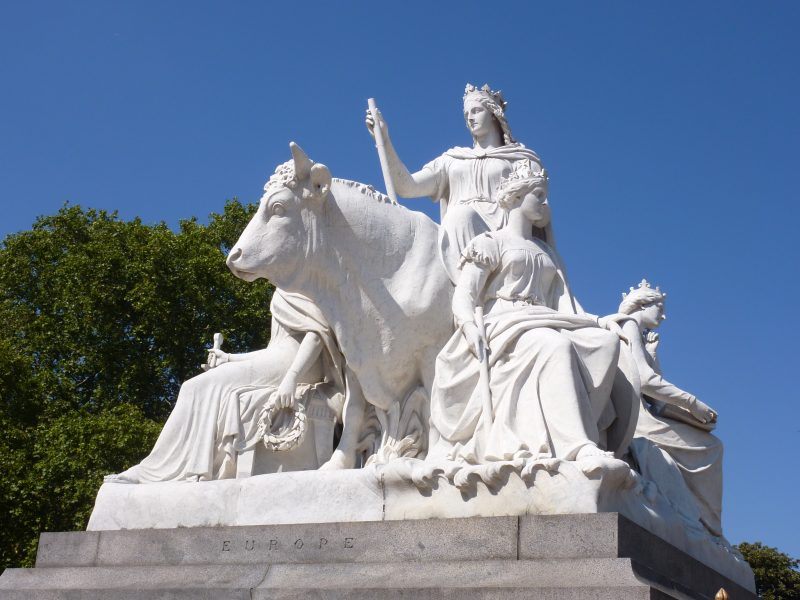
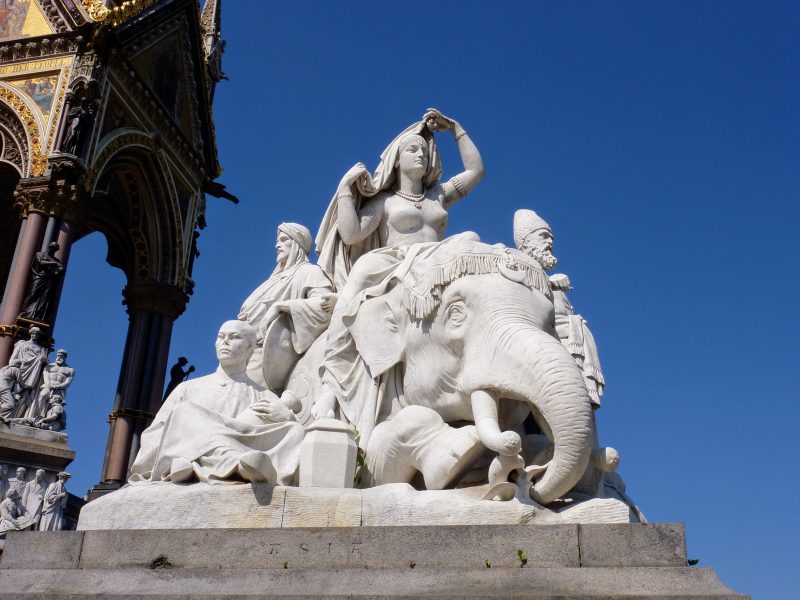
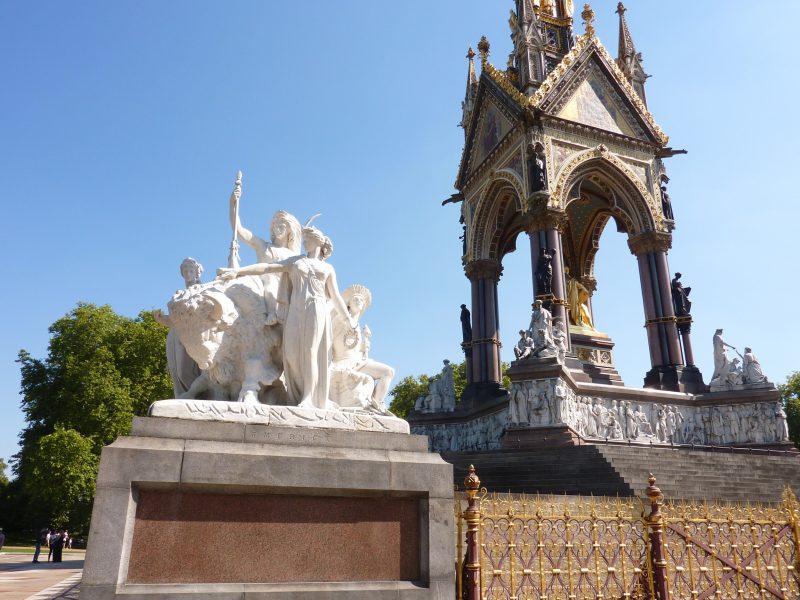
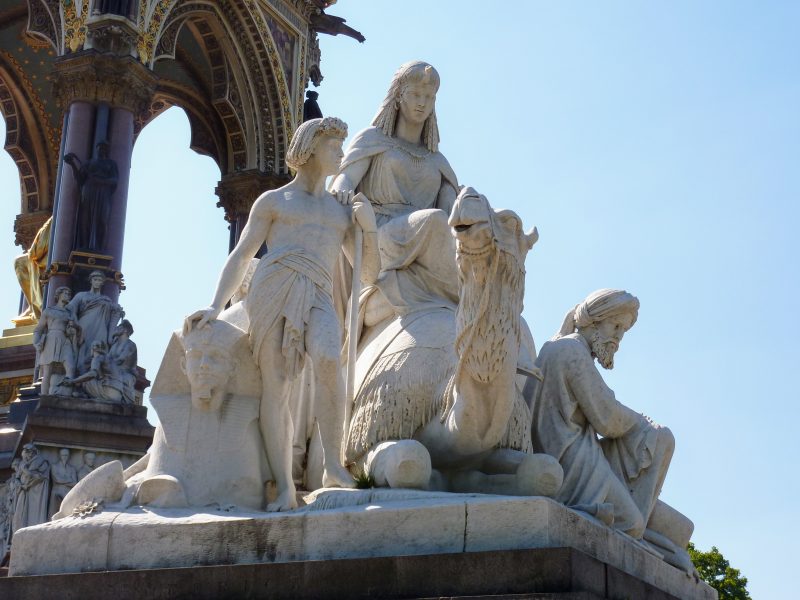
ALBERT STATUE
The centrepiece of the structure is John Foley’s monumental seated statue of Albert in his Garter robes holding the programme to The Great Exhibition of 1851. Initially proposed as a marble statue, it was eventually made of gilded bronze. There was a plan for an equestrian statue, but that would have looked less pleasant from the angle below.
The statue of Prince Albert was installed in 1875. The original sculptor, Carlo Marochetti, had produced different designs for the statue, all considered to be unsatisfactory. He then died, and they had to start again with another sculptor, John Henry Foley, who had worked on other sections of the memorial. As Queen Victoria was paying, he only charged £5,000 instead of the planned £10,000.
The story goes that the gilding was removed from the statue of Prince Albert during WWI so that enemy planes couldn’t use it as a landmark. But a more likely reason was to play down the German ancestry of the British royal family. For most of the 20th century, the statue was black until the restoration that covered the statue in 23.5-carat gold leaf again.
UNDERCROFT
To hold such a monumental memorial, there are 17 feet (5 metres) of concrete foundation and a vast undercroft with 868 vaulted brick arches. That would be amazing to see, but it’s not open to the public. In the very centre is a massive brick funnel which supports the main canopy of the memorial, and in the centre of that is a large brick column which directly supports the bronze statue of Albert itself. The spoil from the excavation was used for landscaping in Hyde Park. Scott called the undercroft “a curiously intricate and picturesque series of catacombs”.
RESTORATION
A dangerously large section of lead fell from the canopy in 1983, and it became more obvious that restoration work was needed. The possibility of disassembling the monument for good was briefly considered but thankfully soon dismissed.
It took some time to decide what to do and to raise the funds, but the memorial was swathed in ignominious wrapping in 1990, so the work could take place inside. There was a £14 million budget to repair the Albert Memorial but, impressively, the project came in under budget at £11.2 million and was also finished a year early. The restored monument was unveiled in October 1998.
The restoration brought the memorial back, as far as was possible, to how it looked in the 1870s. Most Londoners had only seen the statue of Albert as black, but it was gilded again and has seemed incredibly striking ever since.
TOURS
It’s free to admire the Albert Memorial, and it looks fantastic from across the road, outside the Royal Albert Hall. But go on the first Sunday of the month, and there are guided tours that allow you to go inside the railings. Tours are at 2pm and 3pm and last around 45 minutes. As there is so much information to share our 2pm Guide was rushing to be back in time for the next group so I’d recommend taking the second tour, so the Guide doesn’t worry about taking a little longer. Tours run from March to December, and you don’t need to book.


